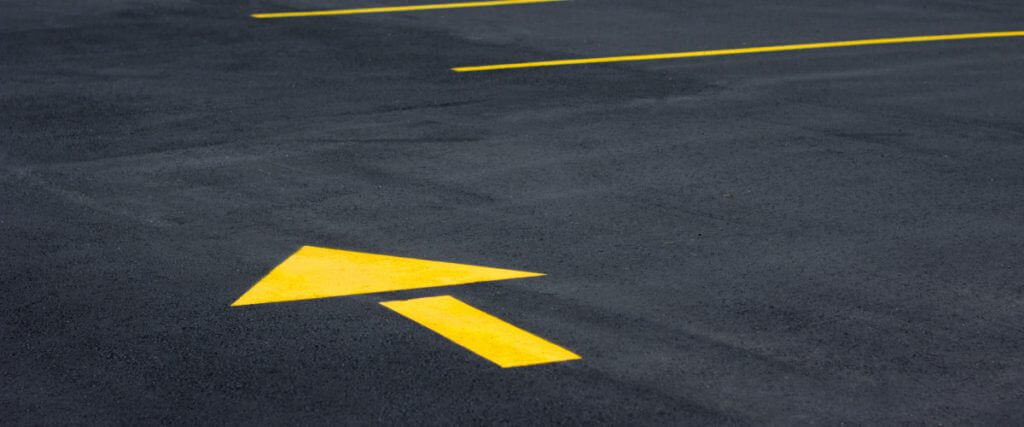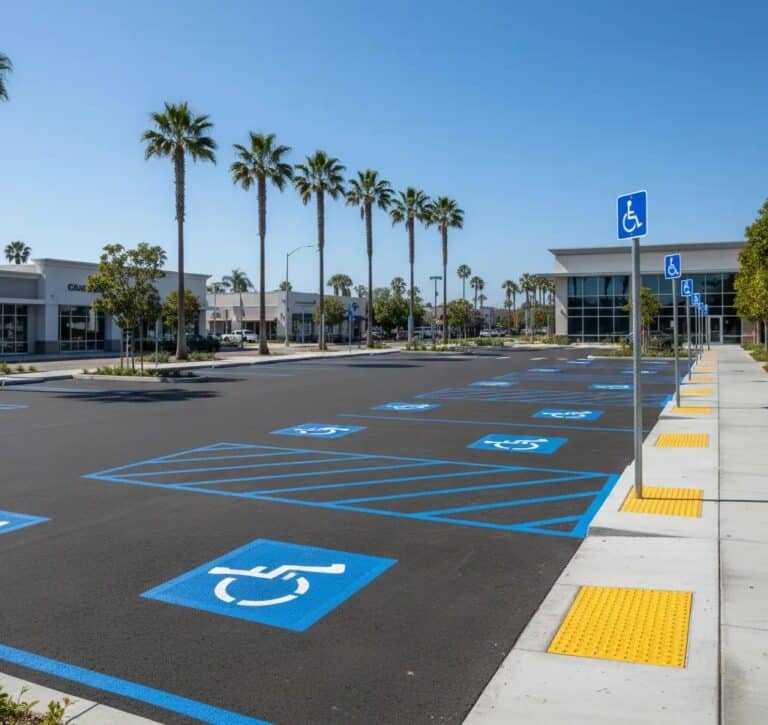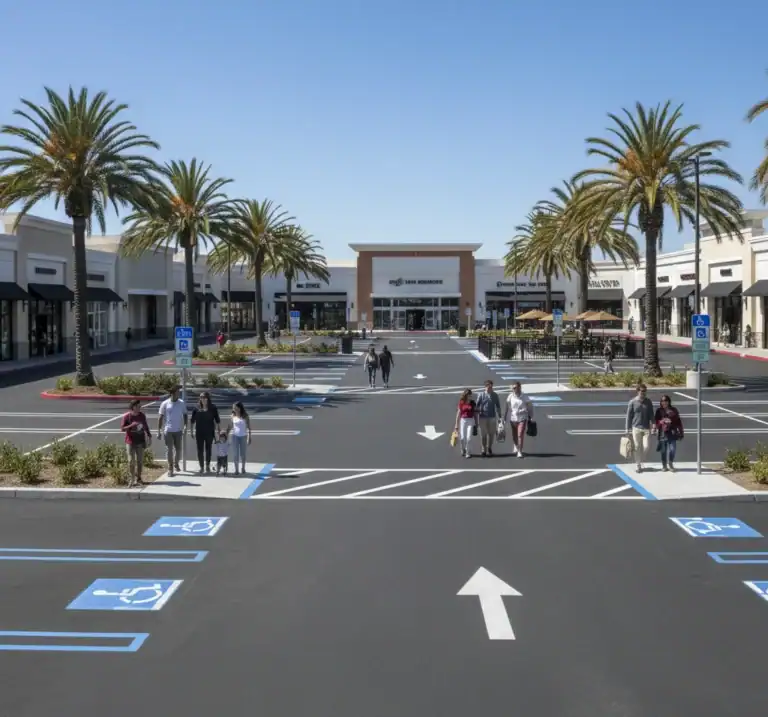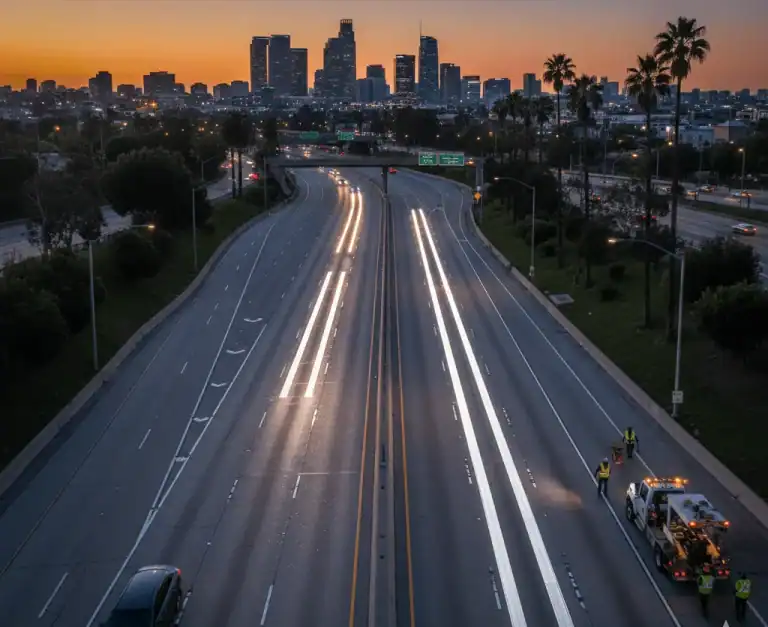Los Angeles highways, like the I-405 with over 400,000 daily vehicles, endure heavy traffic, coastal fog, inland heat, and occasional rain. Faded pavement markings raise collision risks, contributing to 15% of nighttime incidents on major routes, per California highway data. Clear markings define lanes, edges, and hazards, ensuring safe travel for drivers and pedestrians. Paint and thermoplastic are the main materials used. Paint offers quick, cost-effective application, while thermoplastic provides lasting durability for high-traffic areas.
This guide details their compositions, performance in LA’s unique conditions, costs, and compliance with Caltrans and ADA standards. It equips property managers, HOAs, schools, and public agencies with practical knowledge to select materials that enhance safety, reduce maintenance, and meet regulations.
By the end of this article, you’ll know how to:
- Compare paint and thermoplastic for highway applications in Los Angeles.
- Assess weather and traffic impacts on marking durability.
- Evaluate project costs and long-term savings.
- Ensure ADA compliance for accessible, safe markings.
- Select materials based on traffic volume, budget, and project needs.

Understanding Pavement Markings for LA Highways
Pavement markings guide traffic on Los Angeles highways, defining lanes, edges, and pedestrian zones to maintain safe flow. They include:
- White edge lines: Mark road boundaries, as seen on the 10 Freeway.
- Yellow center dividers: Separate opposing traffic, common on Sepulveda Boulevard.
- Dashed lines: Allow passing in designated zones.
- Arrows and symbols: Guide merges, like at the 101 and 134 interchange.
- Bike lane buffers: Green markings enhance cyclist safety near Venice Beach.
Originating in the 1920s to manage growing automobile use, California’s markings align with the Manual on Uniform Traffic Control Devices (MUTCD). Caltrans tailors standards for local conditions, including LA’s 1,200 miles of state highways enduring:
- 14 inches of annual rainfall.
- 300 sunny days accelerating UV wear.
- Temperatures from 50°F to 100°F causing thermal stress.
Markings serve three roles:
- Regulatory: Enforce rules, like solid lines for no-passing zones.
- Guide: Aid navigation, such as curve delineators on the 101.
- Preferential: Prioritize paths, like pedestrian crossings near on-ramps.
On routes like the 10 Freeway, markings withstand 10 million axle loads yearly. Asphalt reaches 140°F, softening weaker materials, while concrete bridges expand and contract, stressing thin coatings. Caltrans requires 250 millicandelas per square meter for white lines, ensuring 1,000-foot visibility at night. For schools near the 5 Freeway or hospitals along the 110, faded markings risk confusion, delaying emergency access and increasing liability.
Historically, oil-based paints served low-traffic roads. Post-1950s, thermoplastics addressed rising volumes. Today, Caltrans uses:
- Paint for low-wear areas like shoulders.
- Thermoplastics for high-traffic lanes, balancing cost and performance.
Environmental rules favor low-VOC materials to reduce stormwater runoff. Smart city pilots on the 101 test LED-embedded markings for low-visibility conditions. Sensors in some markings monitor wear, feeding predictive maintenance models to minimize congestion during repaints.
Example: On the 710, embedded sensors track fade rates, allowing phased applications during off-peak hours, reducing disruptions for 200,000 daily users.
Paint Pavement Markings: Pros, Cons, and LA Applications
Paint-based markings use liquid formulas that dry into protective films. They contain:
- Resins: Binders like acrylic emulsions for water-based latex or alkyds for solvent-based paints.
- Pigments: Titanium dioxide for brightness.
- Glass beads: Enhance reflectivity.
- Additives: Prevent clumping and ensure even spreading.
Types:
- Water-based latex: Dries in 10–30 minutes, low emissions, ideal for urban sites.
- Solvent-based alkyds: Resist harsher conditions, higher volatiles.
- Epoxy: Mixed with hardeners for chemical resistance, needs precise application.
Caltrans approves paints with 80% solids content per Section 84 for durability.
Installation Process:
- Clean surfaces to remove cracks, oil, or debris, critical on LA’s asphalt due to vehicle leaks.
- Use blowers and detergents for preparation.
- Mask areas to prevent overspray.
- Apply paint with airless sprayers at 3,000 psi, using 0.015 gallons per foot for 4-inch lines.
- Drop glass beads into wet paint, embedding 50% for reflectivity.
- Cure in 10–30 minutes for reopening; full hardness in 24 hours.
Paint supports widths from 4 to 24 inches and colors like blue for accessibility, suitable for bridges like the Vincent Thomas.
Pros:
- Costs $0.20–$0.65 per foot (2025 data), budget-friendly for large networks.
- Quick application suits night shifts, minimizing 405 Freeway disruptions.
- Easy removal via grinding or chemicals for redesigns during repaves.
Cons:
- Lasts 1–2 years, dropping to 6–12 months under 50,000 daily vehicles due to tire abrasion and UV degradation.
- Reflectivity halves within months (FHWA tests), reducing wet-night visibility.
- Solvent-based paints contribute to smog; water-based meet South Coast AQMD’s 50 g/L VOC limits.
Example: In 2024, the 710 rehab used latex paint for temporary detours, enabling phased work without closures. On low-volume 110 spurs, paint maintains compliance but requires up to three refreshes over five years, tripling costs.
For HOAs or schools, paint supports annual updates but needs frequent audits. Fast-dry additives, curing in five minutes, aid urgent repairs.

Thermoplastic Pavement Markings: A Deeper Dive for Durability
Thermoplastic markings use solid pellets heated to 400–450°F, forming a fused bond with pavement. They contain:
- Resins (20–30%): Rosin esters or waxes for flow.
- Fillers (40%): Calcium carbonate for bulk.
- Pigments (10–15%): Ensure hue stability.
- Glass beads (20%): Provide reflectivity.
Caltrans requires alkyd thermoplastics with 18% binder content. Preformed sheets are used for symbols like arrows.
Installation Process:
- Clean surfaces to 95% dryness, removing debris.
- Apply primers on concrete to fill pores.
- Heat material in kettles for 20–30 minutes.
- Apply via extrusion for straight lines (0.125-inch thick) or spray guns for curves at 200 psi.
- Add beads post-application, embedding with rollers for 65% retention.
- Cool in 2–5 minutes; traffic resumes after 15 minutes.
Propane-fired units with hydraulic lifts support bridge work.
Pros:
- Lasts 5–7 years, resisting abrasion from 2–3 times more traffic than paint.
- Retains 300 mcd/m² reflectivity for four years, aiding rainy-night visibility on the 10 Freeway.
- Textured fillers increase friction by 0.1, reducing hydroplaning.
- Fewer reapplications save maintenance costs, with FHWA noting 10–15% fewer wet-night crashes.
Cons:
- Costs $1.00–$2.50 per foot due to heating and labor.
- Avoid application below 50°F or in winds over 15 mph, limiting seasonal windows.
- Removal requires grinding 0.25 inches deep, generating dust.
Example: The 2025 I-5 widening used thermoplastics for 20 miles, maintaining clarity under 200,000 daily vehicles. At the 405-101 interchange, preformed arrows endured turning stresses.
Environmentally, thermoplastics emit 1.5 kg CO2 per kg but reduce impact by 40% due to longevity. Bio-based resins cut petroleum use, aligning with CARB goals. A 2024 Orange County arterial halved repair calls with thermoplastics, ensuring smooth peak-hour flow.
Request a free site assessment from ADA Striping to evaluate thermoplastic suitability.

Paint vs. Thermoplastic: Head-to-Head Comparison for LA Projects
Paint and thermoplastic meet Caltrans standards but differ in performance for LA highways:
| Factor | Paint | Thermoplastic |
| Durability | 1–2 years; fades under UV and 50,000 daily vehicles | 5–7 years; resists abrasion and thermal stress |
| Initial Cost | $0.20–$0.65 per foot; lower material costs | $1.00–$2.50 per foot; higher due to heating |
| Long-Term Value | Higher; 3–5 reapplications cost $1.50–$3.00 over 5 years | Lower; single application costs $2.00–$3.50 total |
| Visibility | High initially; drops 50% in 6 months due to bead loss | Retains 80% reflectivity for 4 years |
| Application Time | 1–2 hours per mile; no heat needed | 2–4 hours per mile; quick cure after heating |
| LA Weather Fit | Chips in rain; fades in 300+ sunny days | Resists rain and heat up to 160°F |
| ADA Alignment | Starts compliant; fading risks accessibility | Stable contrast ensures consistent access |
| Environmental | Low-VOC water-based; frequent applications increase waste | Higher energy use; fewer applications reduce impact |
Key Differences:
- Durability: Paint erodes via solvent evaporation, leaving porous films. Thermoplastics fill asphalt cracks, maintaining integrity at LA’s 85°F average highs.
- Cost: Paint costs $15,000 yearly for a 10-mile highway; thermoplastics cost $8,000 every 6 years.
- Visibility: Paint’s 400 mcd/m² drops to 150 in wet conditions; thermoplastics hold 350, reducing incident risks by 15% on foggy 101 stretches.
- Weather: Paint chips in rain; thermoplastics repel water, cutting hydroplaning.
- Application: Paint applies in any weather; thermoplastics need dry conditions.
Example: A 2025 Pasadena arterial used paint for budget lanes, needing mid-year refreshes. A Fullerton highway chose thermoplastics, requiring no early fixes, aligning with 5-year warranties.
For traffic under 20,000 vehicles daily, paint is cost-effective. Above that, thermoplastics ensure reliability for routes like the 405.
Ensuring ADA Compliance and Safety in Your LA Pavement Markings
ADA standards ensure highway-adjacent markings support accessible navigation. Title II requires:
- 36-inch-wide paths for wheelchair access.
- 1:20 slopes at approaches.
- Detectable warnings, like truncated dome tiles, at curbs.
California’s Building Code (CBC Section 11B) mandates high-contrast striping, such as:
- Blue hashes for 8-foot van spaces.
- 60-inch signs for visibility.
Non-compliance risks:
- $75,000 federal fines, escalating to $150,000 for repeats.
- $20,000 in attorney fees per case.
- Over 500 annual LA suits targeting highway-adjacent parking.
Paint fades unevenly, blurring ramp edges and violating 70% contrast ratios, confusing low-vision users. Thermoplastics maintain 90% edge clarity, ensuring accessibility. Clear markings reduce pedestrian-vehicle conflicts by 30% (NHTSA), critical near 405 on-ramps in dense areas. Zebra stripes (8 inches) with 50-foot lead-ins prevent jaywalking on arterials.
Example: A 2024 audit on the 710 fixed 15% non-compliant edge lines with thermoplastic overlays, restoring access without repaves. Schools near the 405 use blue zones extending 20 feet from entries, reducing arrival hazards.
Compliance Steps:
- Check reflectivity quarterly (100 mcd/m² for yellows).
- Remove old layers to prevent shadowing.
- Use thermoplastics for skid resistance (0.15 higher than paint), meeting Caltrans’ 45+ standards.
- Document with photos and logs for DOJ audits.
Hybrid approaches paint for low-use medians, thermoplastics for lanes optimize compliance and safety.
Contact ADA Striping for a free compliance check to avoid costly violations.
Why Choose ADA Striping for Pavement Markings? Your Trusted Partner
- Decades of Expertise: 40+ years delivering durable pavement markings across Los Angeles highways and arterials.
- Certified & Compliant: CASp-certified team ensures ADA, Caltrans, and MUTCD standards are met, avoiding costly fines.
- Durable Materials: Thermoplastic and epoxy markings withstand heavy traffic, sun, and rain for years.
- Safety-First Solutions: Reflective beads and raised-profile lines enhance visibility and reduce accidents.
- Comprehensive Service: From planning to inspection, every step is managed efficiently.
- Trusted Results: Schools, HOAs, hospitals, and agencies rely on our precise and reliable work.
- Rapid Response: 24/7 support ensures roadways stay safe and traffic flows smoothly.
Ensure your roads remain safe, visible, and fully compliant with ADA Striping’s expert solutions.
Testimonials:
- “Lines stayed sharp through heavy traffic, meeting county specs.” – Public Works Lead
- “Compliant markings improved school access safely and on time.” – District Manager
- “Quick fixes kept our lots open during peak hours.” – HOA Board
Free assessments use traffic data for tailored plans, ensuring safety for schools, HOAs, and commercial properties. With a 90% client return rate, ADA Striping delivers consistent, durable results.
Call (714) 500-7901 or submit an online form for a free CASp inspection to ensure safe, compliant markings.
Conclusion
Pavement markings in Los Angeles ensure safe navigation on highways like the I-405, handling 400,000 daily vehicles. Paint offers quick, budget-friendly updates for low-traffic areas, while thermoplastics provide 5–7 years of durability, reducing crashes by 25% (FHWA). Compliance with Caltrans and ADA standards prevents $75,000 fines and ensures accessibility. Choosing the right material based on traffic and budget creates reliable infrastructure. ADA Striping delivers expert, tailored solutions for safe, compliant markings.
Take Action Now: Request a free CASp inspection quote to ensure durable, compliant markings. Call (714) 500-7901 or submit an online form today.






